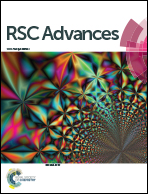Selective colorimetric sensing of Co2+ and Cu2+ using 1-(2-pyridylazo)-2-naphthol derivative immobilized polyvinyl alcohol microspheres†
Abstract
An optical analytical naked-eye sensor was proposed based on the complexation reactions of the 1-(2-pyridylazo)-2-naphthol derivative with heavy metals in aqueous solutions. The prepared colorimetric sensor was characterized by scanning electron microscopy, energy-dispersive X-ray fluorescence spectrometry, and Fourier transform infrared spectroscopy, which indicated a spherical sensor and its molecular composition. In the sensing experiment, notable changes in color and absorbance intensity of the colorimetric sensor for Co2+ and Cu2+ were observed at pH 5 and 4, respectively. The proposed method provided consistent data reliability, with a detection limit of 1 and 5 μM by the naked eye and 0.23 and 0.95 μM by UV-vis spectrometry for Co2+ and Cu2+, respectively. The prepared chemosensor can be used as a colorimetric sensor to monitor Co2+ and Cu2+ with satisfactory results, which validate its value in practical applications in environmental systems.


 Please wait while we load your content...
Please wait while we load your content...